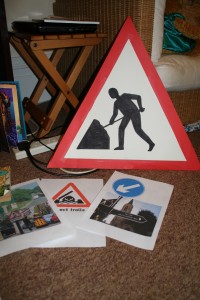On Friday we had our third Lent group. We had a split session, children first and adults later on. This post reports on the children’s session.
We began the session with a prayer and then watched the scene from ‘The Miracle Maker’ which shows the ‘cleansing of the temple’, the gospel for this Sunday. The children filed this away in their brains for later and we looked at some road signs and talked about what they mean. One of the group then showed us a sign language sentence, which the children had to try and work out. (Tricky as it was “Sharks eatoctopus cake”) All of the signs pointed to something else (an obstacle in the road or a destination) or had meaning to them.

We looked at some icons. These work in a similar way. They aren’t just art. They point beyond themselves to invite us into prayer and contemplation of Christ. The children then ‘pulled out’ the thoughts about watching the Miracle Maker and we looked at pictures of the temple and of the over-turned stalls. The temple was the place where God’s presence resided. The stalls were in the court of the Gentiles. This was the only place where non-Jews could come to be near to God’s presence. No one can pray with the noise of moneychangers, goats and doves surrounding them. This points to Jesus making the Kingdom of God about everyone. His Passion and Resurrection make it possible for all nations to join the People of God. We then looked the temple. In the gospel, Jesus says “Destroy this sanctuary and in three days I will raise it up.’ He is talking about his own body. The temple is the place where the presence of God is. Jesus is using the temple as a sign. It points to him. He is the place where God is.
The second half of the materials for Lent 3 focuses on the Liturgy of the Word. To help the children understand the themes contained in the reflection we did two activities. Firstly, we did a ‘test’ to find out how stories come alive for people. I read an extract from ‘Peter Pan’ about the home of the Lost Boys. Then I showed the same part of the story to the children from a pop-up book. The children were asked which they found helped the story come alive better. The older ones generally preferred the written account, making their own pictures in their head. The younger ones generally preferred the pop-up book. One rather tall ‘child’ found that having both helped the scene come to life. When we hear Scripture read in Mass, we can find that it comes alive to us in different ways.
The second activity required aprons as the children had to plant bean seeds in pots. Everyone seemed to enjoy playing with the compost! We looked at the means they planted. We do not make a seed grow. It germinates by itself. If we have a dud seed, whatever we do it will never grow into a live plant that bears fruit. However, if we put our seeds into the pot and do nothing with it, our seed will not grow into a healthy plant. It may try, but will never get to the point of growing beans to eat. Scripture has been provided by God. We don’t create it. However, if we don’t listen, with our ears, our brains and with our hearts God cannot bring its fruit into our lives. Listening to the Word requires co-operation with God.
After all this hard work, we prayed our paraphrase of the Anima Christi and Fr Neil gave everyone a blessing to finish.










 Posts
Posts